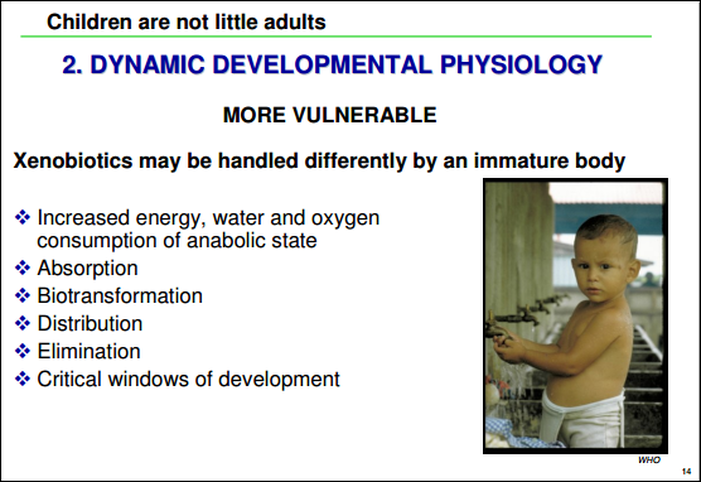
A 2004 review of pesticides research by the Ontario College of Family Physicians showed links between pesticides and reproductive problems, Alzheimer's disease, Parkinson's disease, several different forms of cancers, and childhood leukemia. Since then, more impartial independent studies have been done contributing to a growing body of work indicating the same health hazards of pesticide use.
If the alternative to a lawn free of weeds means fewer health risks to children, pets, pregnant mothers, species in our rivers and lakes, and our pollinators, maybe some 'weeds' aren't so bad.
Back in 2001 The Supreme Court of Canada had to uphold power of municipal governments to restrict the use of pesticides within their communities. The case involved a municipal bylaw passed in Hudson, Quebec, that was challenged by two companies that routinely applied pesticides. The companies argued that municipalities lacked the power to control local pesticide use. Beyond Pesticides, Eco-justice, and other environmental groups successfully argued that municipalities have an important role to play in protecting the health of residents and the environment. Since then, cosmetic pesticide bans have spread to municipalities across the country.
There is even a 'ban/restriction' in Calgary, funny ban though, some call it the 'Do nothing ban', I call it the 'Frank's Red Ban' they spray that *%#! on everything! There are clauses just like any by-law, golf courses are exempt, commercial application by lawn and landscape companies, (this includes the Calgary parks department) and every pesticide is still on the shelves of most hardware stores for the independent consumer to buy up and spray about. The only thing you won't find any more is 'weed and feed', a mix of fertilizer and herbicide together, but there is nothing to say one can't buy each individual product, and no one has told my neighbour up the street that he shouldn't stand there and spray it all over his lawn at 11 pm at night then fling handfuls of fertilizer on it the next day...
I spoke with Calgary City Parks department about the signage, the inevitable spraying, and the pesticides they are using. This was after my call to city information (311) because I was unable to find anything on the City of Calgary's website. There was postings of neighbourhoods to be sprayed (every neighbourhood in the city) and the times (which are inaccurate due to spraying conditions), but absolutely no details about what is going to be used in our parks and neighbourhoods before it is actually on the ground. I feel this is totally irresponsible and has yet to be addressed or updated on their website. Feel free at this point to call 311 and point out it's still inaccurate website and your concerns about the use of pesticides in your parks and neighbourhoods. The operator told me that most of the complaints were about unsightly weeds. How will things change if we don't voice our concerns?
So, this is what I found out. Seems Calgary Parks Department, in charge of pesticide use in public spaces has been spraying Lontrel to address Canadian Thistle, along with NuFarm Trillium, a 2-4-D based herbicide, and Vantage by Dow, a glyphosphate product, all with associated health risks. During our conversation they did assure me that the products were safe. I find this hard to accept because Monsanto has been sued and found guilty of unlawful labelling of its products having to pay damages, over advertizing that it was non-toxic to humans.
The active ingredient in some of these products is a chemical called 2-4-D that was introduced and now very well now as part of the chemical composition of agent orange, developed during the 2nd world war it was better known for its use in the Vietnam war, leaving over 3 million Vietnamese affected including 150 000 children born with birth defect. These numbers reflect only the populations of Vietnamese that were affected, not the veterans of other countries, or populations of people in neighbouring countries. (1)
Now, Dow Agriscience, a subsidiary of Dow, the chemical company, owns the intellectual property on the chemical composition of 2-4-D and has stated that they have made the composition safer since the days of chemical warfare. 2-4-D is now used in over 1500 different herbicidal products around the world. This fact makes me cringe, not feel better.
Most of the companies testing for safety has been done on single chemicals alone an not in there combinations that can create much more toxic substances. These studies are carried out on rats which have natural genes which allow them to detoxify chemicals much more readily than human models would and even though Environment Canada reported that 2,4-D is the second largest chemical source of lower-chlorinated dioxins in Canada, and we know dioxin are carcinogenic, these substances pass our regulatory bodies that govern them when these bodies are suppose to be protecting us. (2)
As for Glyphosate, this is the brainchild of another multinational chemical corporation, Monsanto, developed in the 70s, glyphosate has recently been indicated recently in colony collapse and disruption of colony function of bees(3), negative health effects in humans; such as endocrine disruption(4), neurological issues(5,6) and different types of cancers(7) , as well as the emergence of superweeds that are resistant to the herbicides and now need stronger and more of the toxic chemicals that most of us don't want in our food supply.(8)
Even scarier, symptoms of pesticide poisoning are often deceptively simple, commonly mis-diagnosed as flu or allergies. They include, but are not limited to, headaches, nausea, fever, breathing difficulties, seizures, eye pains, vomiting, cramps, diarrhea, sore nose, tongue, or throat; burning skin, rashes, coughing, muscle pain, tissue swelling, blurred vision, numbness and tingling in hands or feet, incontinence, anxiety, irritability, sleep disorders, hyperactivity, fatigue, dizziness, irregular heartbeat, high blood pressure, spontaneous bleeding, and temporary paralysis.
This is all on their wrap sheets people, but how many of us read the very, very small print.
Long-term consequences include lowered fertility, birth defects, miscarriages, blindness, liver and kidney dysfunction, neurological damage, heart trouble, stroke, immune system disorders, menstrual problems, memory loss, suicidal depression, cancer, and death. The National Academy of Sciences reports that at least one out of seven people are significantly harmed by pesticide exposure each year in the US. Increasingly, reports from many people around the United States are "beginning to link feeling terrible with the fact the neighbours had the lawn sprayed the day before", notes Catherine Karr, a toxicologist for the National Coalition Against The Misuse Of Pesticides in the US.
Although these products are available and widely distributed in Canada and around the world, they are loosely regulated, and a far stretch from scientifically proven to be 'safe if used as directed'. When the data collected and the studies published are from the very companies that are marketing and profiting from these outcomes, the results most often are positively in favour of the companies. This can be due to study models, or altered and selective recording of experimental results but still within 'acceptable' study models.

There is no governmental regulations on submitting negative results and outcomes on the part of chemical companies before the companies apply for commercial licence or are requested to submit for review ( this means it's easier to fudge the science to get things to market in the first place). This also means that we are lacking a full spectrum in the field of research.
For instance; preliminary testing done on chemical X has 122 separately conducted studies on it's possible negative health effects on in mammals. From these tests the results were as followed; 119 of the well constructed mammalian test were found to have negative effects on reproductive organs, as well as adrenal stress. 3 of the conducted studies found no correlation to negative effects of health. Guess which studies would be published and the grounds for further applications to bring the product to market. The now established 'positive' study models will be replicated by the company to create more positive results. Unfortunately, this is how it works in the lab, but not in real life.
The overwhelming literature that these companies are flooding into the media and the research pool with also skewing meta-analysis for future review. They know what they are doing and have billions of dollars to keep the odds stacked in their favour.
I emailed Health Canada 3 weeks ago to inquirer into a review that had been done on use of 2-4-D and any new evidence of health effects, This review happened in 2008, the statement was publicly published in 2013 (efficient bunch aren't they). I was inquiring into the review process that PMRA (Pest Management Regulatory Agency) follows and what is required of the 'registrant'. They have not gotten back to my request but I found this on their website regarding this particular review on 2-4-D;
“Registrants had committed to the development of new data to address the chemistry and toxicology data requirements, and they were submitted to the PMRA for review. Note that an extended one-generation reproduction toxicity study was conducted in lieu of the two separate toxicology studies. Upon receipt of these data, the PMRA completed a review and determined that they were acceptable and supported the re-evaluation decision for 2,4-D, as described in Re-evaluation Decision RVD2008-11, (2,4-Dichlorophenoxy)acetic Acid. “
Seems the agency (PMRA) that is part of the Health Canada structure, allows registrants (the company that manufactures the product in question) to submit their own findings after conducting their own study and the PMRA will review the company's literature, looks like they even accept half of what was required for this review.
I wish I was able to ask a few questions but all I have received so far is a blanket statement stating someone in the right department will get back to me. I emailed again this morning but am not hopeful of any response. Have some questions yourself about this 'review', feel free to email yourself and try and get some answers. E-mail:[email protected]
This is how our regulatory systems in Canada and many other countries around the world allow studies to be conducted, and gain from this type of skewed system.
A few of the costs associated with bringing and keeping pesticides on the market;
PMRA Proposes New Pesticide Fee Schedules March 2014
▲Charge for reviewing toxicology data for a new active ingredient (AI): Reduced from Can$ 98,248 (US$ 88,711) to Can$ 75,807 (US$ 68,448).
▲A new fee of Can$ 21,617 (US$ 19,519) has been added for the generation of a compensable data list.
▲The review of unassessed AIs with maximum residue limits would see a fee change from Can$ 8,448 (US$ 7,628) to Can$ 125,461 (US$ 113,283).
▲The review of new uses for previously assessed AIs with maximum residue limits would see a fee change of Can$ 8,448 (US$ 7,628) to
Can$ 15,838 (US$ 14,301).
Source;Technologies Science Group Inc.
http://www.tsgusa.com/news/pmra-proposes-new-pesticide-registration-fee-schedules.htm#.Vbp6tPldX2o

Ah! Review.... the new Canadian regulatory agency is reviewing studies submitted by the very company that conducted the experiments and manipulated the gross outcome. There is no regulations that companies have to submit all data and outcomes of all studies conducted, that in and of itself might be a great regulatory practice, but sadly, in Canada, our regulatory bodies don't have the greatest track record for keeping Canadians safe from new products to market.
There has been many pesticides removed from the market over the years as a reactive outcome from overwhelming evidences of negative health effects... does anyone remember DDT, oh yes, you probably do, even though it's been ban in Canada since 1972 it remains in the environment still causing harm. I just wonder why we have such a reactive system instead of a co operative pro active system, I somehow had a sense of pride thinking that Canada and it's protection agencies are smarter than that.... I'm sorely let down, decade after decade.
The Canadian Cancer Society, The World Health Organization, The Ontario College of Family Physicians, The Environmental Working Group Organization, The International Research on Cancer, and growing list of others have been conducting well constructed independent studies that have no conflict of interest and these studies have compiled into a growing body of work relating pesticides with negative health of human, animals, and the environment. So why hasn't Health Canada stepped up?
I step back with my analytical view and ask; what really makes sense here? Science conducted from interested parties, or unbiased parties? I've gone over a lot of study models and most of the publications on both sides have solid case study models. But which side stands to profit? Well they both do in a way, one side profits with billions of dollars in sales annually, the other, with healthy communities, lowering risk of potential cancers in humans, and protecting the environment for long term sustainability.
The system in place has seemed to ironically let us down, Health Canada, and some of it's branches like PMRA have sadly neglected good unbiased science and in turn except the millions of dollars annually from 'registrants' to review their lousy literature and continue to keep toxic substances on the shelves. They have lose laws that corporations can bend and manipulate, and forecasts multi millions of dollars of tax revenue as these corporations net billion dollar profit.
Sick of the Bull?
Some things that you can do right now;
Vote with your dollars;
~buy organic products, this cuts down on agricultural pesticide use. (remember conventional cotton uses more insecticide than any other crop grown)
~Learn more about these mega corporations, what they make, and stop funding them, you might be surprised at some of your 'natural' cleaning and everyday products and who makes them.
~Talk to your neighbours about your concerns about pesticides (it only takes a few reference facts to sound like an expert in the field)
~Learn to make your own cleaner
~Contact your community councilmen/women and voice you concerns
~ Educate yourself about natural lawn care. Find natural ways to treat pests, diotameceous earth, organic corn starch, permaculture, accompany plantings, keeping the lawn mowed, and excepting a few weeds in the sea of manicured green, are just a few things that can start with you.
In Calgary?
Things you can do today;
~Call or use 311 mobile app to voice your concern
http://www.calgary.ca/cfod/csc/pages/311.aspx?redirect=/cs/csc/
~Email, write or call your alderman
http://www.calgary.ca/councillors/Pages/aldermanic-redirect.aspx?redirect=/aldermen/
~Email, write, or call the Mayors office
http://www.calgary.ca/mayor/Pages/home.aspx
I'd love to hear about what you do for holistic yard maintenance, please post your comments below.
Have a Healthy, involved summer!
References;
1)Agent Orange Record
http://www.agentorangerecord.com/impact_on_vietnam/health/
2)NCBI; Pediatric Health 2006; Pesticide assessment: Protecting public health on the home turf
http://www.ncbi.nlm.nih.gov/pmc/articles/PMC2528613/
3)Environmental Science Pollution Research International 2013; Acetylcholinesterase in honey bees (Apis mellifera) exposed to neonicotinoids, atrazine and glyphosate: laboratory and field experiments.
http://www.ncbi.nlm.nih.gov/pubmed/23443944
4)Enviromental Research for Public Health2011; Effects of Endocrine Disruptor Pesticides
http://www.ncbi.nlm.nih.gov/pmc/articles/PMC3138025/
5)Environmental Health Perspective 2004; Association of Pesticide Exposure with Neurologic Dysfunction and Disease
http://www.ncbi.nlm.nih.gov/pmc/articles/PMC1247187/
6)Pesticide Action Network
http://www.panna.org/resources/organophosphates_
7)Canadian Family Physician; Cancer Health Effects of Pesticides, Systematic Review
http://www.cfp.ca/content/53/10/1704.short
8)Union of Concerned Scientist;The Rise of Superweeds--and What to Do About It
http://www.ucsusa.org/sites/default/files/legacy/assets/documents/food_and_agriculture/rise-of-superweeds.pdf